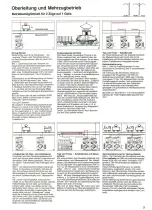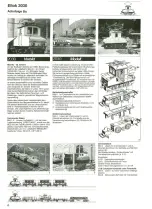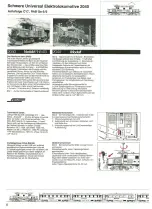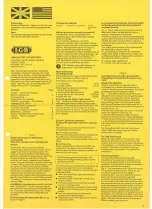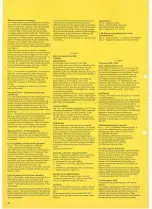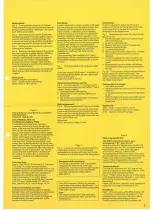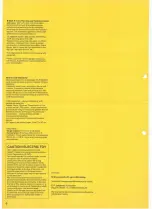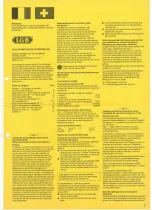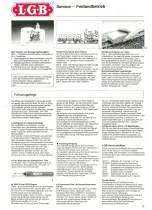
Model details
Fig.2
Turning blinkers (dummy) for tramcar.
These should be stuck onto the tramcar frame at
(he appropriate pos
i
tions
.
Adhesive
:
UHU-Gree-
nit or UHU-Contact
2000
.
Fig.3
Each tramcar and trailer are fitted with
two lighting sockets for internallighting
,
they are
covered with imitation connecting
leads
.
The
enclosed connecting
lead will allow connections
to be made between the tramcar and its trailer
.
Fig
.
4
Platform guard
-
rails can be removed or
rearranged as required.
Fig.5
Bulbs can be easily replaced if one uses
the plastic
t
ube (as supplied with the LGB-Wine
Transport Wagon)
.
After the roof has been
removed
,
this being held in place by means of
snap-on lugs
,
the 2 bulbs
i
n the passenger
compartment
can be replaced. Here one also
finds the changeover
switch for the selection of
rail or overhead traction
.
F
i
g
.
6
When replacing the roof, ca re should be
taken to ensure that the electrical contacts cor-
respond
.
Spare parts:
2030/5 Complete motor block
2210
Contact shoes with springs
5050/1 Bulb 14-18 V, 50 mA.
~ Page 6 -
Heavy-Duty
Universal Electric Locomotive
2040 electronic
Type
C'C',
RhB Ge
6/6
2040 ORIGINAL
RhB 413
The Rhätische Railway (RhB)
The Rhätische Railway which has been
completely
modernized
during the past few
years, is the main rail thorough
f
are Graubün
-
dens
.
Its 394 kilometer long extensive track
layout, is the longest continuous
narrow gauge
railway in Europe. It includes the most important
valleys, the Engadin and the landscapes of
Davos
,
Arosa and the Bündner uplands
.
The
main axis Chur- Thusis-Albula-Engadin
,
lead
further over the Bernina stretch into sunny Italy
,
from Veltlin to Tirano
.
The highlight of a trip on the
Albula line is the experience of the many spec
i
al
constructions:
over a distance of 12
.
6 km. the
track overcomes
a difference in elevation of
416 meters
.
To achieve this
,
4 loop tunnels
,
4 tunnels, 7 viaducts and 2 galle ries were
necessary
.
Technical
Data:
Engine Type RhB Ge
6/6
wheels C'C
.
The small
"Crocodile"
is a heavy universal electric
locomotive lor goods and passenger service
.
The
SLM
-
BBC delivered 15 locomotives
14 of which
are today
,
still being used in the southeast of
Switzerland on the higher alpine routes
.
Year of manufacture
1921-1929
.
Gauge
1000 mm. Locomotive weight 66 tons, 2 motors
1200 H.Power. Single-phase
A.C
.
16
'V
3
Hz.
Max. speed 55 km./h. Overaillength
13.3 m.
Original true electric operation
Locomotives
of the RhB and other European
Railway Comp. with 2 pantographs
,
use however
only one at any time. The second remains
lowered and is used only in case of emergency
.
Fundamentally,
the rear pantograph,
in the
direction of travel is used.
2040 Model
A super model with 2 motors
,
counter shaft axles
and connecting
rod drive through 8 wheels
.
One
friction tyre wh ich increases the locomotive's
tractive power
.
11 different current collecting
points from tracks to the motors
.
Encapsulated
gearings, suitable for open air operation.
First
class track holding in curved sections
,
also on the
tightest bends of the smallest LGB circular track
lay
-
out. Driver
'
s cab doors which can be opened,
complete with fittings and adjustable sliding
windows
.
Richly detailed roof with isolators and
open wiring
,
two pantographs
for twin-train
operation on overhead lines these can be
switched over
.
Large separately fitted headlights for 3 lamp
signalling and driver
'
s cab internallighting
wh ich
automatically
change according to the direction
of travel.
Fig
.
1
On the turntable in the Landquart repair
yards
.
As on their original "Big Brothers
",
in addition to
the tripie signal headlights, the rear, right-hand
lantern is lit at night.
Length incl. buffers 460 mm.
Operating
possibilities,
lighting
Fig
.
3
In driver's cab No. 1
,
mounted into the
rear of the control panel, one can find the
"
Type of
·
traction
"
selector switch
:
1
:
Overhead traction with lighting
0: Off position for track parking
,
lighting and
traction off.
2
:
Rail traction with lighting (Set to this position
before leaving the factory)
.
Bulb replacement
Fig
.
4
Middle headlight bulb
:
Snap-out the bulb
.
Lower headlight bulbs: Unscrew the bulb
-
holder
Driver
'
s cab internallighting
:
Unscrew the roof.
Don't cross the connecting
leads! Correct order
when replacing, from left to right: brown with red
spot, brown, black, red
.
Spare bulb:
5015/1 Micro
-
bulb 5 volts, 33 mA.
-:-
Page 7 -
Fig
.
5
A sheet of renumbering
decals with the
locomotive
numbers 411-415 and neutral
designations
is included with every locomotive
.
This allows an individuallocomotive
designation
.
Recommended
transformer
The Electric Locomotive
2040 is one of the
most powerfullocomotives
in the LGB
programme
.
To ensure a perfect operation we
recommended
the use of our Transformer
-
Controller-Combination
5006-5007 or
5006
-
5012
N.
The LGB-Locomotive
2040 is an authentic
scale model
01
the original "Big-Brother
"
.
It is
assembled from more than 600 separate parts
in the LGB-Factory
.
Care
The fulcrum points of the crank-shaft
pins
should be occassionally
oiled, just like their
"Big-Brothers
".
Dismantling
In orer to replace the carbon brush current
collectors 2110
,
the contact shoes 2214 or the
friction tyre 2010/4
,
the gear-box must be
removed from the bogie frame
:
Fig
.
1
Dismantling
should be carried out
i
n the
sequence
1-8:
1
.
Remove the right-hand crank eccentric cam
with connecting
rod
.
2. as above, right-hand side
.
3
.
Remove the fixing screw of the gear-box
.
4
.
Remove coupling bridge
.
5
.
Unscrew snow plough
.
6
.
Remove gear
-
bQx from bogie frame - Friction
tyres and/or contact shoes can now be
replaced
.
7. In order to replace the carbon brushes
,
the
driving wheels shou
l
d be removed from the
axles
.
8
.
Replacement
carbon brushes with Springs
2110 should be fitted according to Assembly
Plan 6a
.
Fig
.
6a
The locomotive is fitted with two different
bogies which a
r
e marked underneath.
The
Gear-box 2040 I is fitted under the d
r
iver
'
s cab
(by the coupling) and has no carbon brushes on
the friction tyred wheel.
Reassembly
of the bogie
~ don
'
t pitch any wires!
-
crank eccenter cams should point in the same
direction
,
-
on the opposite side
,
they shoUld be displaced
by900
,
-
fit intotheflats
in the wheel hubs, withoutforce
!
the connecting
rods should have play after
being fitted
.
Spare parts:
5051
/
1 Plug-in m
i
cro-bulb
5 V
,
33 mA.
2040/5 Two complete motor-driven
bogies
.
2210
Contact shoes with springs
.
Page8
2045 Original RhB 205
The RhB-Locomotives
Ge
2/4
,
axle
arrangement
1 'B1
',
Nos. 201-207
were among the first electric locomotives
to be
put into serv
i
ce by the RhB during the course of
electrification
.
They were manufactured
in
1912
/
1913 by Messrs
.
SLM and BBC
.
A characteristic
of these
,
is the large
,
slow motion
Deri driving motor mounted in the motor housing.
Power drive w
i
thout intermediate
gearbox by
means of SLM-Diagonal
Rod Drive and
countershaft
axle onto the two connecting
rods
.
Technical
details:
Our original Locomotive
No. 205
,
was put
i
nto
service for passenger and freight traffic
.
In 1929
,
end doors were subsequently
fitted.
Fig
.
5
Present where-abouts
:
on a rolling
-
stand
in the Engineer School in W
i
nterthur
.
Locomotive
207 is in the Transport
House in Luzern
,
Switzerland.
Power
:
300 HP
.
Max
.
speed 45 km/h
,
ope
r
ational
weight 37 tons
,
length over buffers 8.7 m
.
2045 Model
Fig.2
An exact replica of the RhB-Original205
Locomot
i
ve
,
complete with all details
,
e
.
g
.
two
openable driver's cab doors with door closing
springs and adjustable
sliding windows
.
Current collection via two driving wheels
,
rail
3



